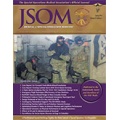Effects of Intraosseous and Intravenous Administration of Hextend® on Time of Administration and Hemodynamics in a Swine Model
Johnson D, Dial J, Ard J, Yourk T, Burke E, Paine C, Gegel B, Burgert J 14(1). 79 - 85 (Journal Article)
Introduction: The military recommends that a 500mL bolus of Hextend® be administered via an intravenous (IV) 18-gauge needle or via an intraosseous (IO) needle for patients in hypovolemic shock. Purposes: The purposes of this study were to compare the time of administration of Hextend and the hemodynamics of IV and IO routes in a Class II hemorrhage swine model. Methods: This was an experimental study using 27 swine. After 30% of their blood volume was exsanguinated, 500mL of Hextend was administered IV or IO, but not to the control group. Hemodynamic data were collected every 2 minutes until administration was complete. Results: Time for administration was not significant (p = .78). No significant differences existed between the IO and IV groups relative to hemodynamics (p > .05), but both were significantly different than the control group (p < .05). Conclusions: The IO route is an effective method of administering Hextend.


 Español
Español 




